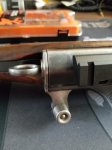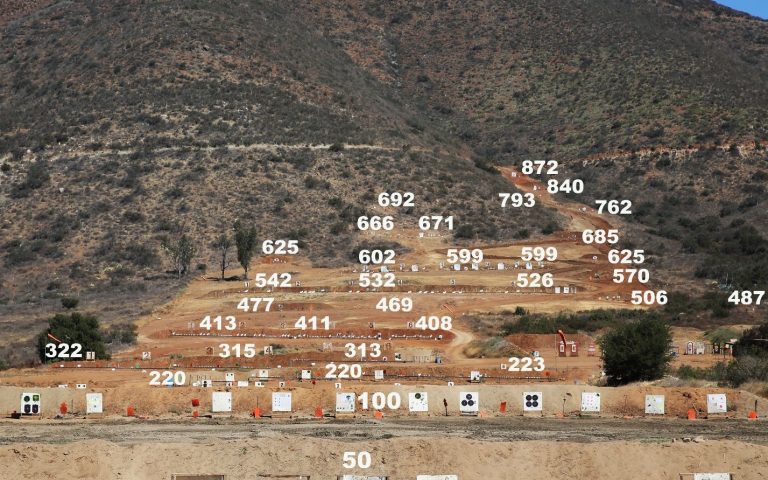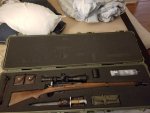I am not at all concerned with the built in accurizing technique of pre-loading the stock. It is now my belief that this accurizing technique from the manufacturer leaves too many variables in the mix. Any flexing of the stock (being in direct, tight contact with the barrel) will change POI at range. If ALL users of the k31 & 1911 were to shoot their rifles with the identical technique, EVERY time, I may not have an argument concerning the armory shim/pre-loading methodology. But............none of us do shoot identically other than those in the shooting clubs, and, I suspect, even those good folks introduce physical variables of their own at times. So...............
I've invested quite a bit of time in arriving at a rather simple conclusion I had always known, from experience, to be true. "Do not interfere with the barrel". That simple. Of course, none of us want to remove that classic stock and fore grip from the Schmidt Rubins, so I did the next best thing. I relieved all reasonable stress contact from the barrel.
I did this by designing a "spacer" meant to go between the flanges of both barrel bands. This simple spacer relieved the barrel of any meaningful contact with the stock. If the spacers are used correctly, the fore stock will feel "loose" at the barrel band. Of course, one could rout out the raceway to relieve the barrel, but I am loathe to remove any wood from the stock. Allowing the barrel to vibrate uninhibited definitely tightened up my groups. I had, of course, used a load capable of moa for these tests. This also meant that I could not use the sling in any kind of a bracing action. That would negate my efforts. Now for the second discovery. I found that "balancing" the tang screw against the receiver screw also had an effect on accuracy.
To determine spacer width requirements, loosen the screw on the front band until the band retainer will compress and release freely. The space you see between the flanges approximates the thickness required for the spacer. With the spacer(s) installed, the front to the stock should have a bit of "play", so that you can see/feel it move when you wiggle it. The rear band should also NOT grip the stock tightly. It, too should have a bit of play. This will leave the barrel relatively uninhibited by the stock. Also remember not to use the sling to "brace" the rifle. That tension will put pressure against the barrel too. Use the sling just to "steady" the rifle without undue pressure.
After installing the spacers, I begin by loosening both screws. I coat the rear screw with LocTite. I then tighten the receiver screw dead tight. I turn the tang screw down tight and back it our 3/4 of a turn or a little better. You'll need to have around 30 dependable loads ready for this test. Definitely do it from a bench rest, and if you have open sights, use a clearly defined target at no more than 75 yards.
Fire a group of 3 or 4 rounds. Tighten the tang screw in 1/8 turn increments, repeating the process and, using a new target for each run, note how the groups will spread or tighten to minor degrees. These differences will make themselves manifest at range. Once you find the "sweet spot" with the tang screw, allow it to sit while the LocTite cures.
This procedure will be all the more apparent with scoped rifles, but the Diopter and Willaims will also show clearly what a difference can be made. Emails from subscribers to this method have proven to me that this method definitely works. Why "fix something that ain't broke"?......... because mine have the capability to outperform the ones that "ain't broke". The rest is up to the shooter.
Something I forgot to add. The k31/55 barrel band does NOT compress the stock tightly against the barrel. At least mine doesn't. This, and the fact that the bipod is attached to the receiver, tells me that someone in the armory felt that the barrel should be uninhibited too.
Just so we have some reality into this.......... I've always said that there are many k31's that work very well with the preloaded stock, but the stock has to be an "as original issued" stable stock. Sometimes improper storage and simple age will cause a stock to apply pressure in the wrong direction, and those rifles are the main reason for our using spacers and screw balance to accurize our rifles. We never, ever remove wood.
Another possible way is to change the lug shim, but once again, if the stock puts pressure left or right on the barrel, then that may not help much. When I said that every rifle in the armoury is set up with his accurizing technique, that doesn't mean that yours must be. It's just like reloading. There are many ways to get to a great end result, not just this way. It works for us based on the stock/barrel relationship of our individual rifles.
Check your forestock. Is the blackened area only straight down on the bottom. or does is show an uneven area of dark wood to the left, right, off dead center or the upper foregrip? And don't forget that the flanges on the front ring must be tight and solid. The stock should not be flopping around when fired.
I strongly disagree with the notion that my method accurizing these Swiss rifles is a mistake. It depends entirely on the current stock/rifle relationship, and in the past 20 years I've proven that many times over right here in the SP armoury.
Do what works best for you, and it might be that your k31's preloaded stock is perfectly fine, but because of the age and storage of these rifles, I've found that to be a minor exception........ Not the rule, and an over the bore mount is never a good idea. Yeah, yeah... I've read all about "deflectors" and we already have a number of prototypes on a shelf in the shop. They never work 100% without denting that rather valuable RUAG or even Norma brass, and if it does not field test 100% for 100% of the time....... we won't manufacture it.
I thank you..... Leslie thanks you. Leslie Salt Co @1887 |





